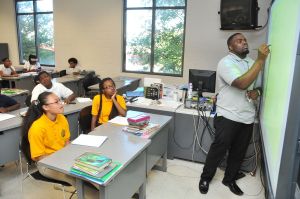Faculties looking less and less like the students they teach
Oct. 26, 2013
No school factor — not budget, not class size, not curriculum — is more important to a child’s experience in the classroom than the teacher, but that’s not how we treat teachers in the United States, and it shows.
About 40 percent of teachers leave the profession within the first five years of starting their careers — 46 percent according to a 2003 study by University of Pennsylvania professor Richard Ingersoll — more than any other profession.
The reason? Generally, it’s the working conditions, compounded by the fact that the job — arguably the most important job for ensuring the well-being of our children and the long-term health of our democracy — barely pays the bills.
It’s perhaps the ultimate manifestation of decades of public policy-making that is hostile to public education, and to some degree it hurts all of us. But like all bad public policy, it hurts some more than others.
In today’s report, “Color blind in the classroom,” reporter Justin Hinkley offers a prime example.
read more
“Across the area, across the state and across the country, teaching staffs do not reflect the growing diversity of public school classrooms. While 20 percent of area students are of color, just 3 percent of local teachers are. Male teachers of color are especially lacking, with women teachers outnumbering men three-to-one.”
Some readers may ask themselves, “So what? What do ethnicity and gender have to do with the quality of classroom instruction?” If the only factors to consider were academic credentials or instructional competency, the answer may be little to nothing, but classrooms and schools aren’t laboratories, they are human communities that must manage and overcome human frailties in a complex and often emotional setting in which kids are not always at their best.
In a multicultural classroom, diversity matters. A lot.
Teachers of color serve as role models for students, giving them a clear and concrete sense of what diversity in education — and in our society — looks like. A recent review of empirical studies also shows that students of color do better on a variety of academic outcomes if they’re taught by teachers of color.
The relationship is far deeper, however, than one of skin complexion. It’s about cultural competency and the ability for students and teachers to identify with one another.
In a study last year, Howard University’s Ivory A. Toldson and Mercedes Ebanks reviewed the response patterns of nearly 9,000 students who completed the National Crime Victimization Survey: School Crime Supplement of 2009.
“We found that black students were less likely to perceive empathy and respect from their teachers and more likely to view the school as a punitive learning environment than white students,” Toldson wrote in an essay for theroot.com.
Toldson went on to write that many teachers may be operating under an implicit association bias, whereby on a subconscious level, they may view black children as security risks.
That may be difficult for many educators, who enter their profession for noble reasons, to accept, but the fact of the matter is that these perceptions exist, and those perceptions help to explain the stubborn achievement gaps between white students and students of color.
Recruiting diversity is part of the answer, but we suggest that it’s not the biggest part. New research from the University of Pennsylvania and UC Santa Cruz suggests that teachers of color, who are leaving the profession even faster than their white counterparts, want more influence over school direction and more autonomy in the classroom to teach what works.
In other words, they’re frustrated by the “teach to the test” mentality that is steadily destroying our nation’s public school system.
We’ve often written how high stakes tests are killing our schools, and the achievement and diversity gaps are among many indications of exactly how. As we said, bad public policy hurts all of us, but it always hurts some more than others.




Connect with us
Facebook
Twitter
Blogger
Youtube